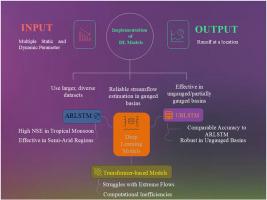From gauged to ungauged: Large-scale deep learning rainfall-runoff modelling for reliable streamflow estimation in India's diverse basins
IF 4.6
2区 环境科学与生态学
Q1 COMPUTER SCIENCE, INTERDISCIPLINARY APPLICATIONS
引用次数: 0
Abstract
Runoff estimation in India faces challenges due to diverse climate zones, complex physiographic conditions, and variable rainfall patterns, limiting traditional hydrological models and prompting exploration of advanced deep learning methods for improved streamflow prediction. Existing deep learning hydrological models struggle to estimate discharge at ungauged sites. In this study, we tested eight different deep learning models, four recurrent neural networks (GRU, CudaLSTM, EALSTM, ARLSTM) and four attention-based architectures (Transformer, Informer, Reformer, Linformer), across 144 watersheds in the Indian subcontinent (ISC). Our training and testing datasets combined meteorological forcing, catchment attributes, and observed discharge records. According to the results, ARLSTM improved prediction accuracy, achieving a median Nash–Sutcliffe Efficiency (NSE) of 0.71 on test basins. ARLSTM performs exceptionally well in specific regions: tropical monsoon areas (median NSE = 0.849), semi-arid regions (median NSE = 0.586), monsoon-influenced subtropical zones (NSE = 0.688), and tropical wet–dry climates (NSE = 0.539), especially in arid zones where traditional hydrological models often struggle. The assessments of high- and low-flow frequencies and durations, mean discharge, and runoff ratios underscore ARLSTM's capability to capture both extreme and average flow conditions. ARLSTM's reliance on lagged streamflow limits its use in ungauged basins. To address this issue, we developed a novel deep learning architecture, Ungauged Basin LSTM (UBLSTM), to predict the runoff values for any ungauged basin in India. UBLSTM matches the performance of ARLSTM, making it a better choice for areas in India that lack sufficient data or have ungauged basins across various climate zones.

从测量到未测量:大规模深度学习降雨径流模型,用于印度不同流域的可靠流量估计
由于不同的气候带、复杂的地理条件和多变的降雨模式,印度的径流估算面临挑战,限制了传统的水文模型,并促使探索先进的深度学习方法来改进流量预测。现有的深度学习水文模型难以估计未测量站点的流量。在这项研究中,我们在印度次大陆(ISC)的144个流域测试了8种不同的深度学习模型、4种循环神经网络(GRU、CudaLSTM、EALSTM、ARLSTM)和4种基于注意力的架构(Transformer、Informer、Reformer、Linformer)。我们的训练和测试数据集结合了气象强迫、流域属性和观测到的排放记录。结果表明,ARLSTM提高了预测精度,试验盆地的纳什-苏特克利夫效率(NSE)中值为0.71。ARLSTM在特定地区表现异常出色:热带季风区(NSE中位数= 0.849)、半干旱区(NSE中位数= 0.586)、受季风影响的亚热带(NSE = 0.688)和热带干湿气候(NSE = 0.539),特别是在传统水文模型常常难以实现的干旱区。对高流量和低流量频率和持续时间、平均流量和径流比率的评估强调了ARLSTM捕捉极端和平均流量条件的能力。ARLSTM对滞后水流的依赖限制了它在未测量流域的应用。为了解决这个问题,我们开发了一种新的深度学习架构,Ungauged Basin LSTM (UBLSTM),用于预测印度任何未测量流域的径流值。UBLSTM与ARLSTM的性能相当,使其成为印度缺乏足够数据或在不同气候带中没有测量盆地的地区的更好选择。
本文章由计算机程序翻译,如有差异,请以英文原文为准。
求助全文
约1分钟内获得全文
求助全文
来源期刊

Environmental Modelling & Software
工程技术-工程:环境
CiteScore
9.30
自引率
8.20%
发文量
241
审稿时长
60 days
期刊介绍:
Environmental Modelling & Software publishes contributions, in the form of research articles, reviews and short communications, on recent advances in environmental modelling and/or software. The aim is to improve our capacity to represent, understand, predict or manage the behaviour of environmental systems at all practical scales, and to communicate those improvements to a wide scientific and professional audience.
 求助内容:
求助内容: 应助结果提醒方式:
应助结果提醒方式:


